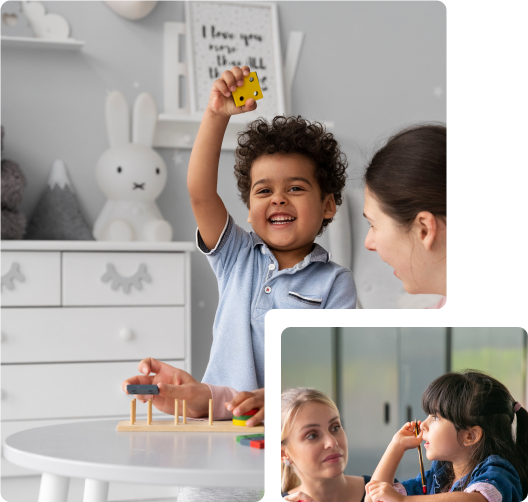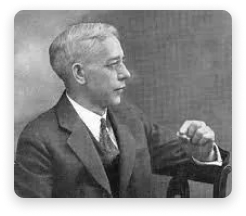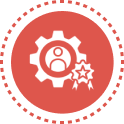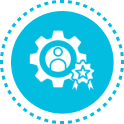Orton Gillingham

What Is The Orton- Gillingham
Approach?
The Orton-Gillingham (OG) Approach is the ‘gold standard’ approach for remediating and teaching children with Dyslexia who struggle in reading, writing, and spelling, despite having average to above-average intelligence. It is an approach, not a method, program, or system. It was developed by Dr. Samuel T. Orton and Anna Gillingham in the 1930s.
The Orton-Gillingham Approach is the chosen approach used by many well-known reading programs such as the Barton Reading and Spelling System, Slingerland Approach, The Sonday System, and the Wilson Reading System.
This approach emphasizes the importance of designing individualized lessons based on children’s learning needs, current skill levels, and individual strengths and weaknesses. The skill areas taught directly and explicitly include phonemic awareness, alphabet skills, letter-sound correspondence, decoding, phonics, spelling, reading, fluency, morphology, vocabulary, comprehension, handwriting, and writing.
The hallmark of this approach is the use of multisensory teaching to break down the barriers in learning by integrating the visual, auditory, and kinesthetic-tactile pathways to teach children to read, spell, and write.
Who were
Orton and Gillingham

Dr. Samuel Orton

Dr. Anna Gillingham
The Principles Of Orton-Gillingham

Personalized
Each student's unique learning needs are taken into consideration when designing lessons and selecting instructional strategies and materials.

Diagonastic & Prespective
Continuous monitoring of oral and written responses helps identify student difficulties and directs future lesson planning. Resolving student's challenges and building on the success from the previous lesson makes it prescriptive.

Direct & Explict
Direct Instruction is provided clearly. Students are taught the structure of the English language which includes the rules and generalizations through modeling and guided practise.

Multi-Sensory
This approach uses all the learning pathways: visual, auditory, and kinesthetic-tactile. Modeling and practicing with the different pathways can produce increased understanding and success in learning literacy skills.

Systematic & Structured
Concepts and skills in the English language are taught in a logical and ordered way.

Sequential, Incremental & Cumulative
Content is presented step by step from simple to more complex concepts and links previously taught material to newly taught material. Mastery of language skills is the goal before moving to the next step.

Children who fall behind their peers in reading by end of grade 1 are more likely to struggle by the end of grade 4. Research shows that they will not achieve average-level reading skills by the end of elementary school. Children who do not read proficiently by the end of 3rd grade are four times less likely to graduate high school on time.
There is a sense of urgency because it gets increasingly more challenging to close the gap after grade 2. The focus switches from ‘learn to read’ to ‘read to learn’. Therefore, early intervention is the best prevention and should be a priority when helping children with Dyslexia.
If Your Child Is Reading Below Grade Level, Getting The Right Kind Of Help Immediately Is Critical!
Your child is a good fit for one-to-one OG therapy if he or she:


Has a formal diagnosis or

can focus and work online

has mild to moderate attention and minimal behavioral challenges

can understand and speak English (Note: the language of instruction is English)

has a history of literacy struggles in one or more of these areas: phonemic awareness, alphabet skills, phonics, sight word recognition, spelling, morphology, reading, fluency, vocabulary, comprehension, writing, and handwriting.
NILD Approach
What is NILD ?
NILD has a unique intervention program for struggling learners. This intervention is language-based educational therapy targeting areas of weakness in processing, memory, attention, oral and written language, reading, spelling and math. Discover the tools for teaching how to learn in a what to learn world. it aims the intervention just above the student’s level of functioning and raises expectations for performance. Students are trained to view themselves as competent, confident learners. The goal is to provide a personalized game plan to support cognitive, emotional, and behavioral blocks to learning. Various learning disabilities, emotional or behavioral problems, or other difficulties are supported. A few examples are: Reading challenges. Issues with attention.
NILD’s logo, the figure eight, represents four key components developed through NILD educational therapy-cognition, perception, emotion, and academics.
The figure eight is incorporated in an activity called Rhythmic Writing that helps to strengthen attention, processing skills, and handwriting. Rhythmic Writing is one of over twenty educational therapy techniques that NILD-trained educational therapists employ to enhance their students’ ability to learn.

How and Why does the program work ?
Research is indicating that thinking can be changed through intensive, focused intervention. Student are trained to think for themselves rather than depending upon a teacher or parent to thin for them.
Language and thinking skills are interdependent so that one skill develops the other is also strengthened. Educational therapists are trained to develop language and thinking through effective questioning. Students are taught to defend their answers and to redirect upon their thinking processes.
They transition from dependent learners to those who think and reason independently. Following NILD Reductional Therapy® treatment few, if any, adjustments or modifications need to be made in the students’ academic programmes
NILD educational Therapy® versus Tutoring
The focus of NILD Educational Therapy® is the development of clear, efficient thinking.
Students are given tools to enable them to overcome specific learning weaknesses. Tutoring typically focuses on content while educational therapy builds efficient learning processes.
NILD Educational Therapy ® teaches students how to think rather than what to think. NILD Educational Therapy ® is skill-oriented, improving basic learning skills so students can learn and retain content.
Educational therapists individualise intervention by focusing specially on students’ areas of difficulty and dealing with problems as they arise during the actual learning process. they maintain the intensity of focus needed to help the student work through difficulties and they develop the trust needed to free the student to accept and work on difficult areas.
FIE
What is the Feuerstein method?
The Feuerstein Method is applied to help children and adults hone their thinking and learning skills. This method is based on the theory of Structural Cognitive Modifiability (SCM) which believes that to create a change, a person needs intervention through Mediated Learning Experience (MLE)
The methodology of the Feuerstein approach consists of four pillars: dynamic assessment, cognitive activation, mediated learning and shaping a modifying environment
Instrumental Enrichment Program aims at systematic use of cognitive functions, as prerequisites of specific problem-solving and real coping. Each instrument serves a particular cognitive function, also addressing many other deficiencies.
If you have questions about the opportunities available to you in our programs, feel free to send us a message. We will get back to you as soon as possible.
